Tomatoes are unpretentious plants that are easy to care for, but in order not to get small or sick fruits, you will need to pay a little attention to the culture. The plant responds very well to regular watering and dressing, rewarding gardeners with a bountiful harvest. In this review we will talk about the proper care of tomatoes after planting in open ground.
Table of contents
Stages care for tomatoes after landing in the ground
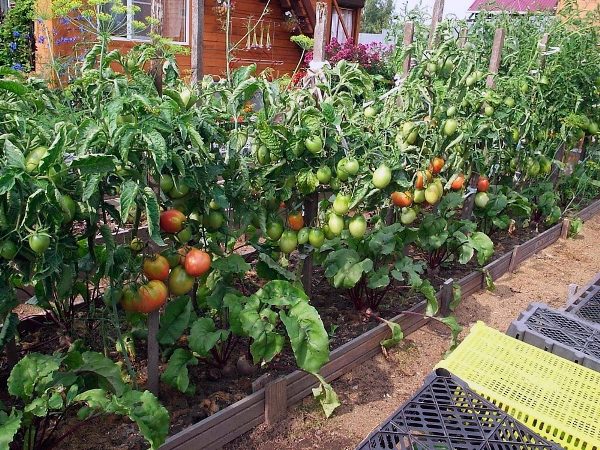
After selecting a variety and planting seedlings on a tomato bed, it is necessary to ensure timely care, which consists in supplying the plant with nutrients and moisture. In addition to basic needs, there are others that have no less impact on the growing season. The details of the work can be found in this article.
Correct watering
Tomatoes react equally to the lack and excess of moisture, so irrigation is carried out as the soil dries. Before flowering, the frequency is 1 once a week, during the formation of the fruit watering is increased to 2-3 once a week. In hot weather with high daytime temperatures, it will be necessary to water the soil every other day or even daily (focus on the degree of dryness of the soil). Procedures should be carried out only in the early morning or late evening. The evening is preferable, since the moisture will last longer in the ground, which means that the plant will be more comfortable.
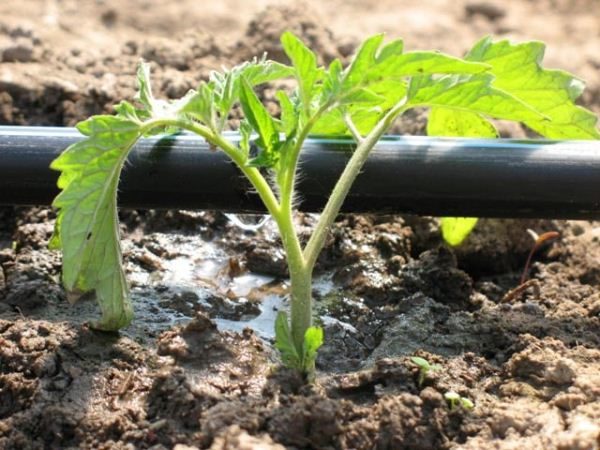
Equipping the irrigation system, preference should be given drip or underground option. Sprinkling moisturizes the tops, while increasing the risk of developing fungal diseases, in particular, top rot. Irrigation can also be carried out under the root or along the grooves. For the prevention of diseases, it is recommended to add wood ash to the settled water. And when the ovaries appear, ash powder is sprinkled around the bushes for better fruiting.
It is not recommended to use tap water for moistening. More well suited and warmed up well variant. The rate of fluid per bush is 8-10 liters.
Masking of tomatoes
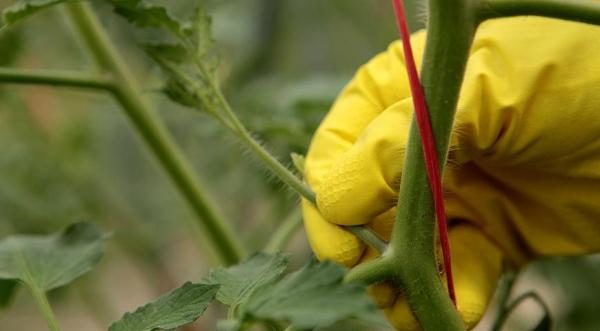
Some gardeners underestimate the procedure of staving tomatoes, considering that a branchy bush and a large number of shoots increase yields. In fact the plant lacks strength for all the ovaries, therefore, small fruits are more often formed or simply do not have time to ripen. The problem is solved by removing useless shoots. This should be done while they are still small (3-5 cm). If time is lost, and they have already gained growth, then it does not make sense to carry out a pasynkovanie.
The procedure is carried out in early August. From the bush remove all stepchildren, leaving 2-3 leaf over the fruits. Sometimes it becomes a pity to tear off the inflorescences, but this will benefit the ripening fruits (they will be much larger).
Another way of pinching involves removing extra shoots every 10 days. In this case, one of the options for the formation of a bush is chosen: in one stem, in two or three. The choice is based on the brand.
Spraying against pests and feeding
Spraying the beds with tomatoes should not only be based on the fact of insect detection, but also for prevention, as among the solanaceous crops, tomatoes are the most vulnerable. What do you ask to splash?
At the planting stage, the roots of seedlings are soaked in an insecticide solution. (for example, Aktar) to protect against wireworms, cockchafer and aphids.Before the period of fruiting, the beds are periodically treated with fungicide preparations (Kvadris, Ridomil Gold), which prevent the development of fungal diseases.
You can use folk remedies. Spraying the bushes with infusions of onion peel, wood ash, and garlic is considered quite effective. To scare off insects suitable decoctions of fragrant plants: pharmaceutical chamomile, wormwood, calendula, etc.
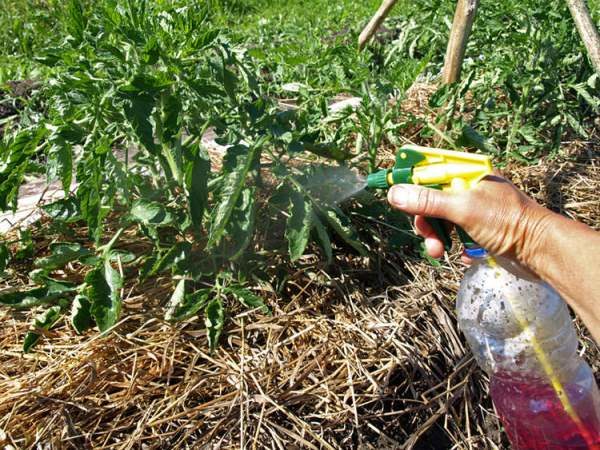
To feed tomatoes need at least three times during the growing season. On nutrient-poor soils, this is done systematically every 2 weeks. Fertilizers are used both organic and mineral. The nitrogen content in them should be less than potassium and phosphorus. How much fertilizer to process?One of the options provides for such a composition:
- 50-60 gr. superphosphate;
- 30-40 gr. potassium chloride;
- 15 gr. ammonium nitrate;
- 10 liters of water.
Culture responds well to the solution of bird droppings. It is preferable to use complex fertilizers that contain trace elements such as magnesium, boron, copper, zinc. Among the popular tools: Master NPK-17.6.18, Kristlon and others.
Hilling and loosening
After each watering, it is advisable to slightly loosen the soil (the immersion depth is about 3 cm). This contributes to the retention of moisture in the soil, provides access to oxygen. The first loosening can be done after the first irrigation of the seedlings. Regularity of procedures - 1 once in 10-14 days When the bushes grow and narrow the aisles, loosening can be stopped.
To stimulate the formation of additional adventitious roots, hilling of tomato bushes is recommended. They are formed from the bottom of the stem, but only in wet soil. Row the soil under the plant should be several times during the season. The first procedure is carried out in 2-3 weeks after planting the seedlings. The second time hilling in the beds is done after 2 weeks.So as not to injure the tomatoes, the event is combined with loosening and weeding.
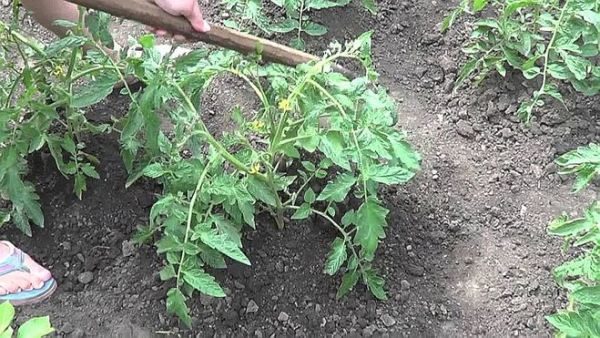
Shaping tomato bushes and breaking leaves
It is necessary to form bushes only in those plants that are prone to branching. If a variety is characterized by the development of a single stem, then the need for a procedure is eliminated.
There are several ways to form bushes:
- in one stem;
- in two stalks;
- in three stalks.
When deciding on an option, it is worth considering the characteristics of the variety and the climatic conditions of the region. The south of the area, the more branches can be left on the tomato. It is important to note that the fruits that are not formed on the main stem will be smaller.
When choosing a method in one stem All stepchildren who have reached a length of 3-5 cm should be removed. To prevent the tomato from shedding all the flowers and ovaries, it is recommended to cut off first of all the shoots grown under the brushes.
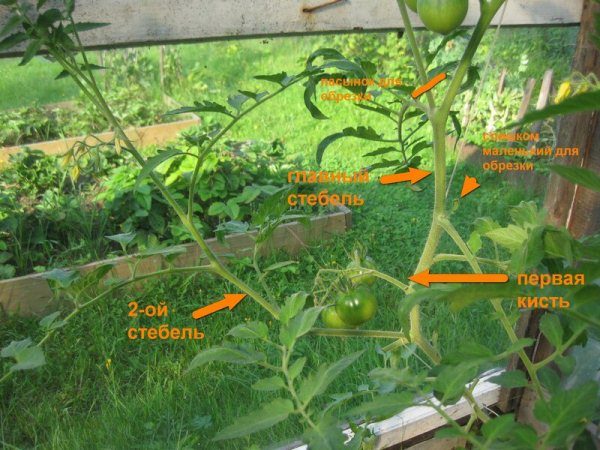
If a tomato is formed in two stalks, then you need to leave a side shoot, which was formed near the first brush.And when choosing the third method, it is recommended to leave the strongest stepchild developing under the second brush.
Cut off the sprouts should be very carefully, clasping them with your thumb and forefinger. Need to pull over yourself, and abruptly to the side. You can also use a knife with a sharp blade. When cutting the stepson, do not affect the main stem, it is better to leave 1-2 mm of the removed shoot.
Soil mulching
Covering the soil with mulch makes it possible to reduce the amount of watering, weeding and loosening. Such savings are simply necessary for summer residents visiting sites only on weekends. In addition to reducing the complexity of the process, the soil is protected from drying out.
The feasibility of mulching can be assessed on the basis of the following advantages:
- decline weed growth (reducing the amount of weed);
- stabilization temperature conditions and soil moisture;
- defence from moisture evaporation;
- prevention bark formation on the ground surface;
- earthworms better bred under a kind of fur coat, which increases the friability of the soil.
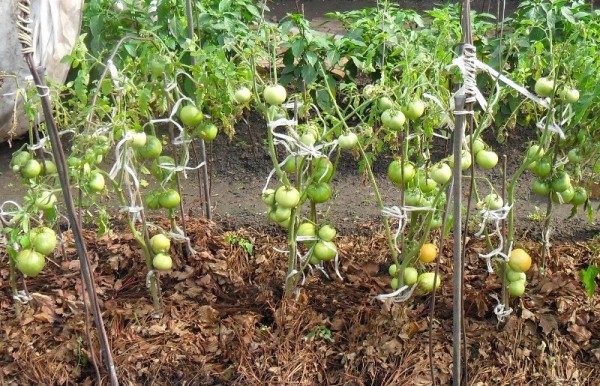
Peat, dry leaves or straw, sawdust are used as mulch. Also fallen compost will do. In the garden departments of hypermarkets today you can buy artificial mulch, which differs by multiple use. Layer must be near 6-8 cm, to let light pass through it. This will prevent the rapid growth of weeds.
Surrounding the garden with tomatoes attention, it is necessary to observe the measure when watering and fertilizing, otherwise you can get the opposite effect. The needs of plants experienced gardeners are determined by their appearance, therefore 2-3 Once a week you just need to inspect the bushes. Then any identified problem will be easier to localize or eliminate.
